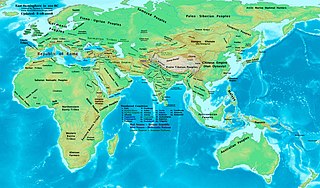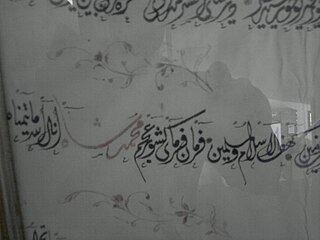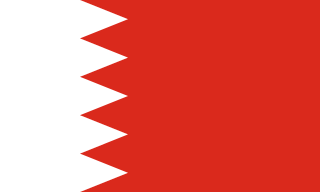
Manama is the capital and largest city of Bahrain, with an approximate population of 200,000 people as of 2020. Long an important trading center in the Persian Gulf, Manama is home to a very diverse population. After periods of Portuguese and Persian control and invasions from the ruling dynasties of Saudi Arabia and Oman, Bahrain established itself as an independent nation in 1971 after a period of British hegemony.
Bahrain was a central location of the ancient Dilmun civilization. Bahrain's strategic location in the Persian Gulf has brought rule and influence from mostly the Persians, Sumerians, Assyrians, Babylonians, Portuguese, the Arabs, and the British.

Gerrha was an ancient city of Eastern Arabia, on the west side of the Persian Gulf.

Dilmun, or Telmun, was an ancient East Semitic-speaking civilization in Eastern Arabia mentioned from the 3rd millennium BC onwards. Based on contextual evidence, it was located in the Persian Gulf, on a trade route between Mesopotamia and the Indus Valley Civilisation, close to the sea and to artesian springs. Dilmun encompassed Bahrain, Kuwait, and eastern Saudi Arabia. This area is certainly what is meant by references to "Dilmun" among the lands conquered by King Sargon II and his descendants.

Tylos was the name used by the Greeks to refer to Bahrain, as the centre of pearl trading, when Nearchus came to discover it serving under Alexander the Great. From the 6th to 3rd century BC Bahrain was included in the Persian Empire by the Achaemenids, an Iranian dynasty. The Greek admiral Nearchus is believed to have been the first of Alexander's commanders to visit the island, and he found a verdant land that was part of a wide trading network; he recorded: "That in the island of Tylos, situated in the Persian Gulf, are large plantations of cotton tree, from which are manufactured clothes called sindones, a very different degrees of value, some being costly, others less expensive. The use of these is not confined to India, but extends to Arabia." The Greek historian, Theophrastus, states that much of the islands were covered in these cotton trees and that Tylos was famous for exporting walking canes engraved with emblems that were customarily carried in Babylon. In addition, Archias of Pella reached the island when Alexander the Great sent him to investigate the course of the coasting voyage to Arabia.

Ajam is an Arabic word meaning mute, which today refers to someone whose mother tongue is not Arabic. During the Arab conquest of Persia, the term became a racial pejorative. In many languages — including Persian, Turkish, Urdu, Azerbaijani, Bengali, Hindi, Kurdish, Gujarati, Malay, Punjabi, and Swahili — Ajam and Ajami refer to Iran and Iranians respectively.

Muharraq is Bahrain's third largest city and served as its capital until 1932 when it was replaced by Manama. The population of Muharraq in 2012 was 176,583.

Failaka Island is a Kuwaiti Island in the Persian Gulf. The island is 20 km off the coast of Kuwait City in the Persian Gulf. The name "Failaka" is thought to be derived from the ancient Greek φυλάκιο(ν) – fylakio(n) "outpost".

Uqair (Arabic:عقير) is an ancient fort of Islamic origin, located in the Eastern Province, Saudi Arabia. It is the first seaport in the Persian Gulf. It is alternatively spelled Al-'Uqair, Uqayr, and Ogair, all Latin transliterations of the same Arabic word. It has been linked by some to the ancient city of Gerrha mentioned in Greek and Roman sources. The site was also the location of the conference at which the Uqair Protocol of 1922 was issued, which helped to establish the borders of modern Saudi Arabia.

Greater Iran refers to a region covering parts of Western Asia, Central Asia, South Asia, Xinjiang, and the Caucasus, where both Iranian culture and Iranian languages have had a significant presence and impact. Historically, this was a region long-ruled by the dynasties of various Iranian empires, under whose rule the local populace incorporated considerable aspects of Persian culture through extensive inter-contact, or alternatively where sufficient Iranian peoples settled to still maintain communities who patronize their respective cultures; it roughly corresponds geographically to the Iranian plateau and its bordering plains. The Encyclopædia Iranica uses the term Iranian Cultural Continent to describe this region.

Pre-Islamic Arabia refers to the Arabian Peninsula prior to the emergence of Islam in 610 CE.
The Baharna are a Shia Muslim Arab ethnoreligious group who mainly inhabit the historical region of Eastern Arabia. They are generally regarded by scholars to be the original inhabitants of the Bahrain archipelago. Most Shi'i Bahraini citizens are ethnic Baharna. Regions with most of the population are in Eastern Arabia, with historical diaspora populations in Kuwait,, Saudi Arabia, Qatar, United Arab Emirates, Oman, Khuzestan Province in Iran, and United States. Some Bahrainis are from other parts of the world too. Some Baharna nowadays, have some sort of Ajami ancestry due to intermarriage between the Ajam and Baharna.

A'ali is a major town in northern Bahrain. It is a part of the Northern Governorate, although from 2001 to 2014 it lay within the Central Governorate. A'ali is famous for its ancient burial mounds, especially several very large burial mounds in the city centre. A'ali is also famous for its traditional handcrafted pottery, which can be seen and bought from different potters and boutiques in the whole town.

Eastern Arabia was historically known as Al-Bahrain until the 18th century. This region stretched from Southern Iraq along the Persian Gulf coast and included regions in Iraq, Bahrain, Kuwait, Eastern Saudi Arabia, United Arab Emirates, Qatar, and Northern Oman. The entire coastal strip of Eastern Arabia was known as "Bahrain" for ten centuries.
Bilad al-Qadeem is a suburb of Manama in Bahrain.

Tārūt Island is an island in the Persian Gulf belonging to the Eastern Province of Saudi Arabia, connected by two causeways to Qatif. It is six kilometers from the coast, and is the longest island in the Persian Gulf after Qeshm Island, extending from Ra’s Tannurah in the north to Qatif in the west. The island has an area of 70 square kilometers, and a population (2010) of 77,757. It contains a number of towns and villages, including Tārūt itself, Deyrah, and Darīn.

The following outline is provided as an overview of and topical guide to Bahrain:

Arad is a town in Bahrain, located on Muharraq Island. It was originally a small farming village inhabited by Baharna Shia, but later expanded to include new middle-class housing, which brought with it a large Sunni population.

Bahrain, officially the Kingdom of Bahrain, is an island country in Western Asia. It is situated on the Persian Gulf, and comprises a small archipelago made up of 50 natural islands and an additional 33 artificial islands, centered on Bahrain Island which makes up around 83 percent of the country's landmass. Bahrain is situated between Qatar and the northeastern coast of Saudi Arabia, to which it is connected by the King Fahd Causeway. According to the 2020 census, the country's population numbers 1,501,635, of which 712,362 are Bahraini nationals. Bahrain spans some 760 square kilometres (290 sq mi), and is the third-smallest nation in Asia after the Maldives and Singapore. The capital and largest city is Manama.
The theatre of Bahrain in its present form originated in the early 20th century, after the introduction of formal education in the country. Though shadow plays and puppet shows were previously widespread in Bahrain, European-style drama plays were first introduced in schools and plays written by Arab dramatists would be later included in the school curriculum.
















